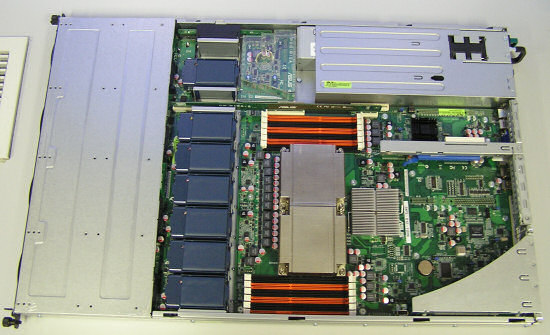The Best Server CPUs part 2: the Intel "Nehalem" Xeon X5570
by Johan De Gelas on March 30, 2009 3:00 PM EST- Posted in
- IT Computing
Benchmark Configuration
None of our benchmarks required more than 16GB RAM.
Each Server had an Adaptec 5805 connected to the Promise 300js DAS. Database files were placed on a six drive RAID 0 set of Intel X25-E SLC 32GB SSDs, and log files on a four drive RAID 0 set of 15000RPM Seagate Cheetah 300GB hard disks.
We used AMD 8356 and 8384 CPUs in dual CPU configurations. Performancewise they are identical to the Opteron 2356 and 2387. So to avoid confusion, we list the Opterons 83xx as Opteron 2356 and Opteron 2384.
Xeon Server 1: ASUS RS700-E6/RS4 barebone
CPU: Dual Xeon "Gainestown" X5570 2.93GHz
MB: ASUS Z8PS-D12-1U
RAM: 6x4GB (24GB) ECC Registered DDR3-1333
NIC: Intel 82574L PCI-E Gbit LAN

Xeon Server 2: Intel "Stoakley" platform server
CPU: Dual Xeon E5450 at 3GHz
MB: Supermicro X7DWE+/X7DWN+
RAM: 16GB (8x2GB) Crucial Registered FB-DIMM DDR2-667 CL5 ECC
NIC: Dual Intel PRO/1000 Server NIC
Xeon Server 3: Intel "Bensley" platform server
CPU: Dual Xeon X5365 at 3GHz, Dual Xeon L5320 at 1.86 GHz and Dual Xeon 5080 at 3.73 GHz
MB: Supermicro X7DBE+
RAM: 16GB (8x2GB) Crucial Registered FB-DIMM DDR2-667 CL5 ECC
NIC: Dual Intel PRO/1000 Server NIC
Opteron Server: Supermicro SC828TQ-R1200LPB 2U Chassis
CPU: Dual AMD Opteron 8384 at 2.7GHz or Dual AMD Opteron 8356 at 2.3GHz
MB: Supermicro H8QMi-2+
RAM: 24GB (12x2GB) DDR2-800
NIC: Dual Intel PRO/1000 Server NIC
PSU: Supermicro 1200W w/PFC (Model PWS-1K22-1R)
vApus/DVD Store/Oracle Calling Circle Client Configuration
CPU: Intel Core 2 Quad Q6600 2.4GHz
MB: Foxconn P35AX-S
RAM: 4GB (2x2GB) Kingston DDR2-667
NIC: Intel Pro/1000
The Platform: ASUS RS700-E6/RS4
We were quite surprised to see that Intel chose the ASUS RS700-E6/RS4 barebone, but it came clear that ASUS is really gearing up to compete with companies like Supermicro and Tyan. This ASUS 1U barebone has a new Tylersburg-36D (Intel 5520) chipset and ICH10R Southbridge.
The ASUS RS700-E6 is a completely cable-less design, which is quite rare. According to ASUS, the gold finger mating mechanism delivers a more reliable signal quality. That is hard to verify but it is clear that a loose connection is much more unlikely than with cables. We have only had the server in the labs a few weeks, so it is too early to talk about the reliability, but we can say that the build quality of the server is excellent. The 6-phase power regulation that feeds each CPU comes from very high quality solid capacitors that are guaranteed to survive 5 years of working at 86°C (typically this is only 2 years). The same is true for the 3-phase memory power regulation. A special energy process unit (EPU) steers the VRMs to obtain higher power efficiency.

A rather unique feature is that this 1U server also supports two full height PCI-E expansion slots and one half-height slot (close to the PSU). The two full height slots are PCI-E x16 slots and the low profile slot is PCI-E x8. In addition, you can add a proprietary PIKE card, which allows you to add a SAS controller. This can be an LSI 1064E Software RAID solution (RAID 0 or 1) or a real hardware RAID card (the LSI 1078) with support for RAID 0, 1, 10, 5 and even 6.

The expandability is thus excellent, especially if you consider that the ASUS RS700 has room for two (1+1) redundant PSUs. We still have a few items on our wish list, though. We would like a less exotic video card with slightly more video RAM; ASUS uses the AST2050 with only 8MB. While many people will never use the onboard video, some of us do need to use it from time to time. The card comes with decent Windows and Linux drivers. Our distribution (SUSE SLES10SP2) would only work well at 1024x768 and refused to work in text mode until we installed the video driver, so it took a bit of tinkering before we were even capable of installing the right driver.
ESX 3.5 Update 3 does not recognize the new Intel SATA controller well, but luckily the ASUS server can be equipped with an ESX3i USB stick. ASUS offers a special USB port inside the server to attach the stick. We are currently circumventing the SATA-ESX issue with an install via ftp.
Overall, this is one of the finest 1U barebones that we have seen to date. We are pleased with the expandability, the excellent fabrication quality, and the 3-year warranty that ASUS provides.










44 Comments
View All Comments
usamaah - Monday, March 30, 2009 - link
Is it me or is page 2 of this article missing some information? The title of that 2nd page is "What Intel and AMD are Offering," but in the body of the text there are only descriptions of Intel's Xeon chips? Perhaps a new title to reflect the body, or add AMD info?JohanAnandtech - Monday, March 30, 2009 - link
I moved the AMD vs Intel pricing data to the back of the article as the pricing info is more interesting once you have seen the results. But forgot to change the title.. fixed. Thanks.usamaah - Monday, March 30, 2009 - link
Cool, thank you. Next time I'll finish reading the article before I make a comment, sorry ;-) Anyway wonderful article.Ipatinga - Monday, March 30, 2009 - link
Very nice to see a comparison over some generations of Xeon platform, including the new one (yet to be released).I would like to see a new article with Core i7 vs Xeon 5500... to check out if my Core i7 @ 3,7GHz is good enough in Maya 2009 (Windows XP 64bit, 12GB DDR3), or if a Xeon 5500 (each at 2,4GHz, for instance) in dual processor configuration will be a much better buy.